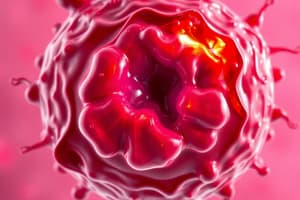Podcast
Questions and Answers
What is the primary reason for cellular injury due to oxygen deprivation?
What is the primary reason for cellular injury due to oxygen deprivation?
- Stable membrane function
- Enhanced aerobic metabolism
- Increased ATP production
- Decreased ATP production (correct)
Which of the following best describes irreversible cellular injury?
Which of the following best describes irreversible cellular injury?
- Damage that leads to apoptosis (correct)
- Transitory respiratory stress
- Cellular swelling that is fully reversible
- Complete restoration of cellular function
What is a significant consequence of ATP depletion in cells?
What is a significant consequence of ATP depletion in cells?
- Formation of new cellular membranes
- Activation of aerobic respiration
- Failure of ATP-dependent pumps (correct)
- Increase in mitochondrial activity
Which component is primarily damaged by ultraviolet light, according to the content?
Which component is primarily damaged by ultraviolet light, according to the content?
What is the effect of the damaged sodium-potassium membrane pump during cellular swelling?
What is the effect of the damaged sodium-potassium membrane pump during cellular swelling?
What pathological condition results from excessive calcium within cells due to membrane damage?
What pathological condition results from excessive calcium within cells due to membrane damage?
Which of the following processes occurs during ATP depletion as cells undergo injury?
Which of the following processes occurs during ATP depletion as cells undergo injury?
Which condition is characterized by reversible cellular swelling?
Which condition is characterized by reversible cellular swelling?
What condition is characterized by the appearance of small clear vacuoles in the cytoplasm?
What condition is characterized by the appearance of small clear vacuoles in the cytoplasm?
Which of the following best describes hydropic degeneration?
Which of the following best describes hydropic degeneration?
What is the first stage of cellular necrosis?
What is the first stage of cellular necrosis?
What process is primarily responsible for programmed cell death?
What process is primarily responsible for programmed cell death?
Which of the following changes is not associated with reversible cell injury?
Which of the following changes is not associated with reversible cell injury?
Which statement is true regarding fatty change in cells?
Which statement is true regarding fatty change in cells?
What role do caspases play in apoptosis?
What role do caspases play in apoptosis?
Which type of cellular damage is characterized by irreversible damages such as organelle breakdown?
Which type of cellular damage is characterized by irreversible damages such as organelle breakdown?
Flashcards are hidden until you start studying
Study Notes
Introduction to Cellular Injury
- Cellular injury refers to changes in cells due to stress from both external and internal sources.
- Cells can adapt to maintain their steady state, however, persistent stress can lead to three outcomes: adaptation, reversible injury, or irreversible injury.
Causes of Cellular Injury
- Oxygen Deprivation (Hypoxia)
- Physical Agents: Trauma, heat, cold
- Chemical Agents: Drugs and other chemicals
- Infectious Agents: Bacteria, viruses, parasites
- Impaired Nutrient Supply: Lack of essential nutrients
- Genetic Derangements: Mutations, genetic disorders
- Immunologic Disorders: Autoimmunity, hypersensitivity reactions
- Iatrogenic: Caused by medical treatment
Targets of Cell Damage
- DNA Damage: Environmental factors and normal metabolic processes can cause DNA damage, leading to millions of molecular lesions per cell each day.
- Cell Membrane Damage: Disrupts the balance of electrolytes, particularly calcium, which can trigger apoptosis or programmed cell death.
Biochemical Changes in Cellular Injury
- ATP Depletion: A key factor in cellular injury.
- Consequences: Failure of sodium-potassium and calcium pumps, leading to electrolyte imbalances and swelling.
- Glycogenolysis: Anaerobic metabolism occurs to compensate for ATP depletion.
- Decreased pH: Impacts cell function and can promote harmful enzymatic processes.
- Nuclear Changes: Leads to pyknosis (clumping of chromatin) and ultimately can lead to cell death.
Types of Cellular Injury
-
Sub-lethal (Reversible)
- Cellular Swelling: Caused by hypoxia, which damages the cell membrane's sodium-potassium pump. This can be reversed if the cause is eliminated.
- Hydropic Change or Vacuolar Degeneration: A more severe form of cellular swelling associated with low potassium levels.
- Ultra-structural Changes: Blebbing, blunting, distortion of microvilli, loosening of intercellular attachments, mitochondrial changes, and dilation of the endoplasmic reticulum are all signs of reversible cell injury.
-
Lethal (Irreversible)
- Necrosis: Characterized by swelling, irreversible membrane damage, and organelle breakdown.
- Stages:
- Pyknosis: Nuclear shrinkage and chromatin clumping.
- Karyorrhexis: Fragmentation of nucleus and chromatin.
- Karyolysis: Dissolution of the cell nucleus
- Inflammatory Response: Leakage of cellular components into the extracellular space triggers an inflammatory response.
- Stages:
- Apoptosis: Programmed cell death of excessive or potentially harmful cells.
- Mechanism: Mediated by caspases, proteolytic enzymes that cleave specific proteins, leading to cell death.
- Characteristics: Cells shrink and condense into small bodies.
- Advantages: Cytosolic products are safely contained by membranes, preventing damage to neighboring cells.
- Consequences: Inhibition of apoptosis can contribute to cancer, autoimmune diseases, inflammatory diseases, and viral infections.
- Necrosis: Characterized by swelling, irreversible membrane damage, and organelle breakdown.
Fatty Change
- Occurs when a damaged cell is unable to adequately metabolize fat, resulting in accumulation of fat vacuoles within the cytoplasm.
- Liver: Can lead to cholestasis (reduced bile flow) due to fat accumulation compressing bile canaliculi.
- Typically reversible.
Studying That Suits You
Use AI to generate personalized quizzes and flashcards to suit your learning preferences.




